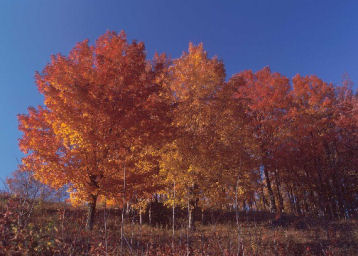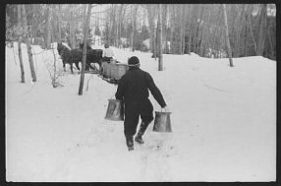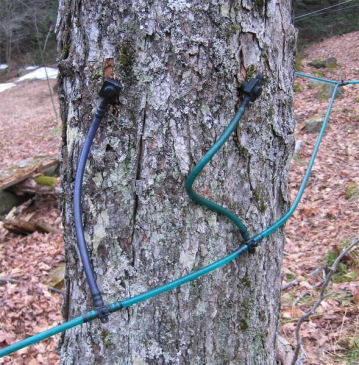Sweet, Sticky Science
Toss out that bucket and kettle: Making maple syrup goes high tech.
By Emily Sohn
Real maple syrup sweetens even the dullest breakfast, and it’s no mystery why. The sticky stuff you pour on your pancakes is at least two-thirds sugar.
People have been collecting sap from maple trees to make syrup for hundreds of years.
But today, new technologies are making the process faster and more efficient. Researchers are even looking into ways to make trees produce sweeter sap in the first place.
“Essentially, there is nothing about the way we produce syrup now that is anything like it was 100 years ago,” says plant ecologist Brian Chabot of Cornell University in Ithaca, New York.
Sugary sugar maples
One thing has stayed the same as far as maple syrup production is concerned: the need for sap-producing trees. More than 100 species of maple trees grow worldwide, but only a few produce syrup-worthy sap. The most popular syrup tree—the sugar maple (Acer saccharum)—grows in the northeastern United States and eastern Canada. A forest of sap-producing maples is called a sugar bush.
 |
|
The sugar maple trees in this Vermont sugar bush turn beautiful colors in autumn, when they also produce sap. |
| Tim McCabe, Natural Resources Conservation Service, U.S. Department of Agriculture |
Only maples that grow in the north produce enough sap for syrup making. Timing is important too. Tree sap flows when below-freezing nighttime temperatures are followed by rapidly warming mornings and above-freezing days.
This ideal weather situation occurs for several weeks in autumn and spring. Most producers, however, make syrup in March. It’s still chilly then, but at least at the end of the season workers can clean their equipment without freezing.
Chabot and his colleagues are analyzing weather patterns to more accurately predict when sap extraction should begin. For now, syrup makers have to estimate the best time to drill the holes, or taps, that let the sap flow.
Sap suckers
The sap that comes from a tree is very watery. It has just 2 percent sugar and only a faint maple syrup taste. To concentrate the sap’s flavor and sweetness, producers must boil away most of the water.
On average, it takes 40 gallons of sap to make just 1 gallon of syrup, says Timothy Perkins, director of the Proctor Maple Research Center at the University of Vermont in Underhill Center.
 |
|
Sixty or seventy years ago, when this photo was taken, people collected sap in buckets, They then carried the buckets to a place where they boiled the sap to make syrup. |
| Marion Post Wolcott, Library of Congress, Prints & Photographs Division, FSA/OWI Collection, LC-USF33- 030891-M2 |
People used to collect sap in buckets and then boil it in kettles. Over time, syrup makers replaced the buckets with networks of tubing that use gravity to move sap from trees to a central refinery, called a sugarhouse. Today’s newest vacuum systems literally suck the sap from the trees.
In a forest in upstate New York, 4,000 taps and 30 miles of tubing are helping scientists learn more about the vacuuming process. The scientists hope to be able to help syrup producers figure out the optimal number of taps, the best size and length of the tubing, and what size pumps will extract the most syrup.
 |
|
Sap from this sugar maple flows into two taps that are connected to plastic tubing. |
| © Jared C. Benedict/Wikipedia |
“With a vacuum,” Chabot says, “You can pretty much double the yield from a maple tree.”
The evaporation process has also been through an overhaul. Machines that take in sap at one end and spit syrup out the other have replaced kettles, Perkins says. The sap travels through a heated “gutter” that helps evaporate the water. Some of these gutters are hundreds of feet long.
Forest for the trees
Other research focuses on the trees themselves. A small percentage of maple trees naturally produce sap with more than double the average sugar concentration, Chabot says. This extra-sweet sap requires less energy to process. So, researchers are planting cuttings from some of these trees. When the trees are grown, the scientists will study them to try to figure out what makes their sap so sugary.
Some new evidence suggests that maple trees might grow faster and produce sweeter sap if they have more access to light. Chabot is developing ways to manage a forest so that maple trees get the right amount of light. He’s also working on methods to predict which trees are best to tap.
One of the biggest concerns for today’s syrup producers is global warming. Over the past 40 years, Chabot says, the spring sap run has come earlier, and the season is now 2 or 3 days shorter than it used to be. That’s a lot of time to lose from a season that usually lasts 30 days at most. As temperatures warm, maple syrup production might retreat farther north.
“It’s very important for sugar makers to be aware of the health of their trees,” Perkins says, because it can take 50 years before a maple is big enough to produce sap. “If you do something that damages the tree, it’s not going to just grow back.”
A matter of taste
As efficient as all these new technologies are, it’s not clear how they’ll affect another important factor: the syrup’s flavor.
Producers send samples of strange-tasting syrups to Perkins and his team for chemical analysis. The scientists try to figure out what went wrong in the syrup-making process.
“I eat plenty of maple syrup, but the funny thing is that what we get isn’t the best, but the worst syrup,” Perkins says. “I expect we will be focusing on [flavors] a lot for the next 10 years.”
Despite all the innovations, scientists have yet to discover the secret of the perfect maple syrup. “There’s quite a bit left to improve,” Chabot says.
Going Deeper:







